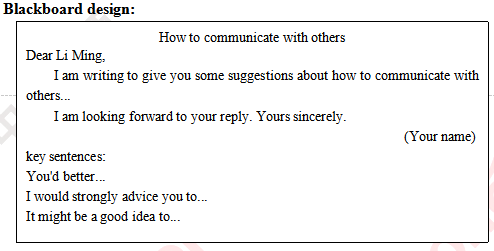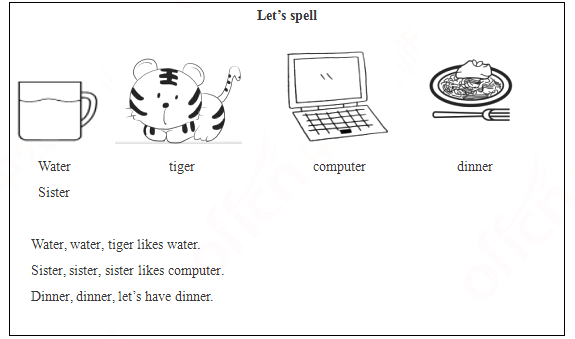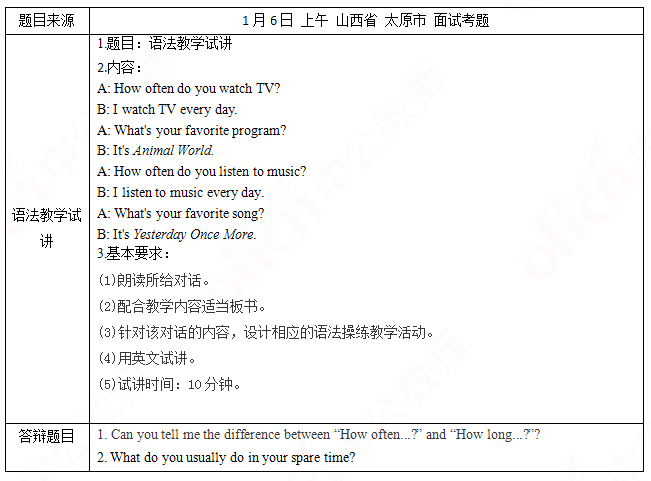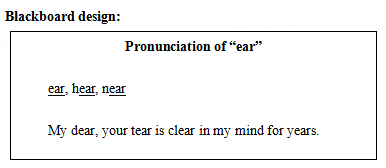In writing, students may not know how to put something into proper English and thus ask their, teacher for help. Here the teacher is to play the role of a/an__________ A.facilitator B.assessor C.controller D.participant
题目
In writing, students may not know how to put something into proper English and thus ask their, teacher for help. Here the teacher is to play the role of a/an__________
A.facilitator
B.assessor
C.controller
D.participant
B.assessor
C.controller
D.participant
参考答案和解析
答案:A
解析:
考查教师的角色。根据题目提供的情境,“写作课上,当学生不知道如何用英语表达某事物时,会向老师寻求帮助”,此时教师扮演了促进者(facilitator)的角色。assessor“评估者”,controller“控制者”,participant“参与者”.均不符合题意。故选A。
如果没有搜索结果,请直接 联系老师 获取答案。
相似问题和答案
第1题:
The teacher gives students 2 minutes to skim a text, and when time is up, he asks students to stop and answer some questions. Here the teacher is playing the role of a (an)__________.
A. assessor
B. prompter
C. participant
D. controller
B. prompter
C. participant
D. controller
答案:D
解析:
考查课堂管理中教师的角色。教师是课堂教学的调控者(controller)、促进者(prompter)、参与者(panicipant)、组织者(organizer)、评估者(assessor)、资源提供者(resource.provider)。此处体现的是教师在课堂上的调控能力.故选D。
第2题:
The teacher asks students to do a group-work task. Before the task, the teacher assigns roles clearly around the class, pointing to each student in turn."You are A ... you are B ..., etc."
Here the teacher plays the role of_______
Here the teacher plays the role of_______
A.controller
B.prompter
C.facilitator
D.organizer
B.prompter
C.facilitator
D.organizer
答案:D
解析:
考查教师角色。教师在要求学生进行小组任务前,先给全班同学分配角色,这体现了教师的组织者角色。故选D。
第3题:
which expression is wrong about learning students' names? ()
A. It shows students that the teacher is interested in them.
B. The teacher could ask individual students to assist with demonstrations.
C. The teacher could ask individual students to assist with equipment in the class.
D. It shows the teacher is responsible.
正确答案是:D
第4题:

二、考题解析
【教案】
Teaching Aims:
Knowledge aim: By the end of the class, students will know some expressions of advice and the format of a letter, which includes: an appellation, a body part, a complimentary close and a signature.
Ability aim: Students’ writing ability of letter can be improved by the end of the class.
Emotional aim: Students will be aware of the importance of writing English letter.
Students' interest of learning English can be inspired.
Teaching Key Points:
Students know the format of an English letter and how to make a suggestion.
Teaching Difficult Points:
Students can apply expressions of advice and the format of English letter into their own life.
Teaching Methods:
Communicative teaching method, task-based teaching method, situational teaching method.
Teaching Aids:
PPT, Blackboard and so on
Teaching Procedures:
Step 1: Warming up
1.Greetings
2.Sing an English song We don’t talk anymore, invite the whole students to clap when singing together and lead to the topic.
Step 2: Pre-writing
1.Free talk: Let students talk about the importance of communication in our daily life in group of four, 3 minutes later invite some groups to show their ideas.
2.Set up situation: Let's say our friend Li Ming is very upset recently, because he has a problem in the aspect of communicating with others, we should write a letter to give him some advice.
3.Format: Guide and teach students the format of English letters, which includes: an appellation, a body part, a complimentary close and a signature.
4.Content: Teach students the key sentence structures about how to make a suggestion.(eg: I suggest that you...)
5.Brainstorming: Let students share their ideas about how to communicate with others with their partners, and decide which are the best ideas, make a list of those ideas, then put those ideas into a map so that students can easily see them when they write.
Step 3: While-wirting
Give students some guidance, such as: pay attention to the punctuation, sentence structure, tenses and format. 15 minutes would be given to them to complete their letter within 100 words individually.
Step 4: Post-writing
1.Self-editing: Ask students to check their letter according to the format and sentence structures on the blackboard.
2.Peer editing: Ask students to check and edit their partners’ letter and give them some suggestions.
3.Share: Invite some students to share their letter in front of the class and teacher gives them some comments.
Step 5: Summary & Homework
Summary : Invite a little teacher sum up what we have learned today.
Homework: Let students search more information about how to communicate with others.

答案:
解析:
暂无解析
第5题:
小学英语?语音
一、考题回顾

二、考题解析
【教案】
Teaching aims:
Knowledge aim:
Students will master the meaning and pronunciation of the word.
Ability aim:
Students will know how to pronounce “-er” in words.
Emotional aim:
Students will be interested in learning English.
Key and difficult point:
Key Point:
Students will master the meaning and pronunciation of the word.
Students will know how to pronounce “-er” in words.
Difficult Point:
Students will be interested in learning English.
Teaching procedure:
Step 1: Warming-up
1. Greetings.
2. Sing a song Finger Family.
Daddy finger, daddy finger, where are you?
Here I am, here I am, how do you do?
Mommy finger, mommy finger, where are you?
Here I am, here I am, how do you do?
Ask them if they know the name of the song. Then may guess it is Finger Family. Then tell them that we are going to learn some pronunciation in “finger”.
Step 2: Presentation
1. Use some riddles to introduce the words. For example, “I will drink it every day. What is it? Yes, it’s water.” Then draw the according pictures(introduce “sister” by explaining its meaning). And write the words at last.
2. Ask the students to read the words after the teacher for twice. Then play high and low voice. If the teacher speak one word loudly, the students should speak it lowly, and vice versa.
3. Ask students to find similarities among the words. They may say that they all contain “-er” at the end of the words. Then introduce the rules of the pronunciation.
4. Ask students if they know other words containing “-er”. They may say “winter”, “river” or others.
Step 3: Practice
1. Finish Read, underline, and say in the textbook. Check answers, and ask students to read after the teacher.
2. Finish Look, listen and write in the textbook. Then invite students share their answers on the blackboard. Give encouragement.
Step4: Production
1. Ask students to make up a chant using the words we learned. For example:
Water, water, tiger likes water.
Sister, sister, sister likes computer.
Dinner, dinner, let’s have dinner.
Step5: Summary and Homework
Summary: ask a student to conclude the content of the lesson and summarize with the whole class.
Homework: chant for the students’ parents.
Blackboard design:

1. What is a good pronunciation lesson?
2. What will you do if one of the students in your class doesn’t do homework?
一、考题回顾

二、考题解析
【教案】
Teaching aims:
Knowledge aim:
Students will master the meaning and pronunciation of the word.
Ability aim:
Students will know how to pronounce “-er” in words.
Emotional aim:
Students will be interested in learning English.
Key and difficult point:
Key Point:
Students will master the meaning and pronunciation of the word.
Students will know how to pronounce “-er” in words.
Difficult Point:
Students will be interested in learning English.
Teaching procedure:
Step 1: Warming-up
1. Greetings.
2. Sing a song Finger Family.
Daddy finger, daddy finger, where are you?
Here I am, here I am, how do you do?
Mommy finger, mommy finger, where are you?
Here I am, here I am, how do you do?
Ask them if they know the name of the song. Then may guess it is Finger Family. Then tell them that we are going to learn some pronunciation in “finger”.
Step 2: Presentation
1. Use some riddles to introduce the words. For example, “I will drink it every day. What is it? Yes, it’s water.” Then draw the according pictures(introduce “sister” by explaining its meaning). And write the words at last.
2. Ask the students to read the words after the teacher for twice. Then play high and low voice. If the teacher speak one word loudly, the students should speak it lowly, and vice versa.
3. Ask students to find similarities among the words. They may say that they all contain “-er” at the end of the words. Then introduce the rules of the pronunciation.
4. Ask students if they know other words containing “-er”. They may say “winter”, “river” or others.
Step 3: Practice
1. Finish Read, underline, and say in the textbook. Check answers, and ask students to read after the teacher.
2. Finish Look, listen and write in the textbook. Then invite students share their answers on the blackboard. Give encouragement.
Step4: Production
1. Ask students to make up a chant using the words we learned. For example:
Water, water, tiger likes water.
Sister, sister, sister likes computer.
Dinner, dinner, let’s have dinner.
Step5: Summary and Homework
Summary: ask a student to conclude the content of the lesson and summarize with the whole class.
Homework: chant for the students’ parents.
Blackboard design:

1. What is a good pronunciation lesson?
2. What will you do if one of the students in your class doesn’t do homework?
答案:
解析:
1.
A good pronunciation lesson should make students master the rules of the pronunciation, and they can apply the rules when encounter the syllables in the future. So in my lesson, I firstly let the students find similarities among the words, then I conclude the rules. After that, I ask them if they know other words that share the same pronunciations. Later, few exercises are conducted so that they can consolidate the knowledge. Thus, I believe I have given a good pronunciation lesson.
2.
Firstly, I will ask him or her to finish the homework as soon as possible. Secondly, I will try to talk with the student patiently to figure out the reason. If the student say that they have too much homework, then I will try to reduce the homework amount afterward. If the student think homework is not important, I will tell that homework is a good way to absorb the knowledge learned today, otherwise they will forget it quickly. Lastly, I will talk to his or her parents to let them also focus on the problem and address it together with us.
A good pronunciation lesson should make students master the rules of the pronunciation, and they can apply the rules when encounter the syllables in the future. So in my lesson, I firstly let the students find similarities among the words, then I conclude the rules. After that, I ask them if they know other words that share the same pronunciations. Later, few exercises are conducted so that they can consolidate the knowledge. Thus, I believe I have given a good pronunciation lesson.
2.
Firstly, I will ask him or her to finish the homework as soon as possible. Secondly, I will try to talk with the student patiently to figure out the reason. If the student say that they have too much homework, then I will try to reduce the homework amount afterward. If the student think homework is not important, I will tell that homework is a good way to absorb the knowledge learned today, otherwise they will forget it quickly. Lastly, I will talk to his or her parents to let them also focus on the problem and address it together with us.
第6题:
The teacher gives students 2 minutes to skim a text, and when time is up, he asks studentsto stop and answer some questions. Here the teacher is playing the role of a(an) __________ .
A.assessor
B.prompter
C.participant
D.controller
B.prompter
C.participant
D.controller
答案:D
解析:
考查教师的角色。教师是课堂教学的调控者(controller)、促进者(prompter)、参与者(participant)、组织者(organizer)、评估者(assessor)、提供资源者(resource—provider)。此处体现的是教师在课堂上的调控能力,故选D。
第7题:
Which role does the teacher play in the following activities? When the students are doing a group work task, the teacher joins one or two groups for a short period of time.
A.source of help
B.controller
C.participant
D.assessor
B.controller
C.participant
D.assessor
答案:C
解析:
本题考查教师的角色。
根据题干中的关键词“join in”,教师加入小组活动中,真正成为小组活动的一员与小组成员互动,可知正确答案为“participant”,综上,C选项正确。
A选项,资源的帮助者,不合题意,故排除。
B选项,控制者,不合题意,故排除。
D选项,评价者,不合题意,故排除。
故正确选项为C。
根据题干中的关键词“join in”,教师加入小组活动中,真正成为小组活动的一员与小组成员互动,可知正确答案为“participant”,综上,C选项正确。
A选项,资源的帮助者,不合题意,故排除。
B选项,控制者,不合题意,故排除。
D选项,评价者,不合题意,故排除。
故正确选项为C。
第8题:
In which of the following situations does the teacher play the role of organizer?
A.Organizing students to do activities by giving instructions.
B.Walking around to offer help to those who need it both in ideas and language.
C.Giving feedback and dealing with errors.
D.The teacher joins in students’ activity.
B.Walking around to offer help to those who need it both in ideas and language.
C.Giving feedback and dealing with errors.
D.The teacher joins in students’ activity.
答案:A
解析:
本题考查教师的角色。
A选项,由关键词“organize”可知,教师的角色为组织者。综上,A选项正确。
B选项,提供给学生帮助,教师的角色为推动者。
C选项,给予反馈,教师的角色为评价者。
D选项,教师参与到学生活动中,教师的角色为参与者。
故正确选项为A。
A选项,由关键词“organize”可知,教师的角色为组织者。综上,A选项正确。
B选项,提供给学生帮助,教师的角色为推动者。
C选项,给予反馈,教师的角色为评价者。
D选项,教师参与到学生活动中,教师的角色为参与者。
故正确选项为A。
第9题:
初中英语?语法
一、考题回顾

二、考题解析
【教案】
Teaching aims:
Knowledge aim:
Students will know the usage of the frequency adverbs and the sentence structure “How often...?”.
Ability aim:
Students can use the sentence structure freely in their daily life.
Emotional aim:
Students will be more confident in learning English and not afraid of speaking English.
Key and difficult point:
Key Point: Students will know how to use the sentence structure in their daily life.
Difficult Point: Students can cultivate their confidence in learning English.
Teaching procedure:
Step 1: Warming-up
1. Greetings.
2. Ask students what they usually do in their spare time and why, and ask some of them to share with the whole class.
Step 2: Presentation
1. Listen to the tape for the first time and find out what the speaker does every day, and then invite students share their answers.
2. Ask students the following questions: how often does the speaker watch TV? How often does the speaker listen to music? And then write down the sentence on the blackboard.
3. Explain the sentence structure to students: the sentence structure is used to ask questions about how many times something has been done or how many times a state exists in a given period of time.
4. The teacher read the dialogue and ask students to read after it to get a deep understanding.
Step 3: Practice
1. Role-play. Ask students work in pairs and role play the dialogue. Then invite two groups to show in front of the class.
2. Play a game: word cards. Invite two couples of students. Ask one student to choose the card in the box and then ask the other students the question “ how often do you...?” using the activities showed in the card, and then change their role.
Step4: Production
Let students work in groups of 4 and discuss on the topic: how often do you...? according to their own hobbies. After that invite two groups to present in the whole class.
Step5: Summary and Homework
Summary: ask a student to conclude the content of the lesson and summarize with the whole class.
Homework: ask students to ask their friends “ how often do you...?” after class and write down on the exercise book.
Blackboard design:

1. Can you tell me the difference between “How often...?” and “How long...?”?
2. What do you usually do in your spare time?
一、考题回顾

二、考题解析
【教案】
Teaching aims:
Knowledge aim:
Students will know the usage of the frequency adverbs and the sentence structure “How often...?”.
Ability aim:
Students can use the sentence structure freely in their daily life.
Emotional aim:
Students will be more confident in learning English and not afraid of speaking English.
Key and difficult point:
Key Point: Students will know how to use the sentence structure in their daily life.
Difficult Point: Students can cultivate their confidence in learning English.
Teaching procedure:
Step 1: Warming-up
1. Greetings.
2. Ask students what they usually do in their spare time and why, and ask some of them to share with the whole class.
Step 2: Presentation
1. Listen to the tape for the first time and find out what the speaker does every day, and then invite students share their answers.
2. Ask students the following questions: how often does the speaker watch TV? How often does the speaker listen to music? And then write down the sentence on the blackboard.
3. Explain the sentence structure to students: the sentence structure is used to ask questions about how many times something has been done or how many times a state exists in a given period of time.
4. The teacher read the dialogue and ask students to read after it to get a deep understanding.
Step 3: Practice
1. Role-play. Ask students work in pairs and role play the dialogue. Then invite two groups to show in front of the class.
2. Play a game: word cards. Invite two couples of students. Ask one student to choose the card in the box and then ask the other students the question “ how often do you...?” using the activities showed in the card, and then change their role.
Step4: Production
Let students work in groups of 4 and discuss on the topic: how often do you...? according to their own hobbies. After that invite two groups to present in the whole class.
Step5: Summary and Homework
Summary: ask a student to conclude the content of the lesson and summarize with the whole class.
Homework: ask students to ask their friends “ how often do you...?” after class and write down on the exercise book.
Blackboard design:

1. Can you tell me the difference between “How often...?” and “How long...?”?
2. What do you usually do in your spare time?
答案:
解析:
1.
The first sentence structure is used to ask questions about how many times something has been done or how many times a state exists in a given period of time. The second sentence structure includes two different usage: one is used to ask how long does it take. It's mainly used to ask questions for a period of time; the other is used to ask for the length of something.
2.
I really have a great passion for sports, i like to do yoga, cycling and jogging. Take jogging for example. It stimulates me to learn more about body -building. Secondly, I am able to meet new friends through my hobby. Lastly, the hobby will teach me some self-discipline, because to do it regularly is so challenging.
The first sentence structure is used to ask questions about how many times something has been done or how many times a state exists in a given period of time. The second sentence structure includes two different usage: one is used to ask how long does it take. It's mainly used to ask questions for a period of time; the other is used to ask for the length of something.
2.
I really have a great passion for sports, i like to do yoga, cycling and jogging. Take jogging for example. It stimulates me to learn more about body -building. Secondly, I am able to meet new friends through my hobby. Lastly, the hobby will teach me some self-discipline, because to do it regularly is so challenging.
第10题:

二、考题解析
【教案】
Teaching aims
Knowledge aim: students will know the pronunciation of the group of letter “ear”.
Ability aim: students can read words with “ear” when they learn vocabulary.
Emotional aim: students will be more interested in speaking English.
Key and difficult points:
How to pronounce the group of letter “ear”.
Teaching procedure:
Step 1: Warming-up
After greeting students, the teacher plays a game to warm up the class: I say you point. The teacher speaks out a certain part of the body and students point it quickly. For example: point your eye! Point your ear! Point your hand!
Step 2: Presentation
Draw a ear on the blackboard and ask students what it is. Write down the word. Then ask what ears can be used to, and they will say we use ear to hear something. Write down word “hear”. Then do the action of hearing and put hands near the ear, and write down the word “near”.
Ask students to read the three words after the teacher, and find out the similarity among them. After discussion, they will say all these words have “ear”. Then ask students how to pronounce this group of letter. We will know it pronounce as /ir/.
Step 3: practice
Give students some other words with the group of letter “ear” and ask students to read them by groups. For example, a sentence “my dear, your tear is clear in my mind for years”. Then students can have a brainstorming and think of more words with “ear”.
Play a game Hot potato to practice these words. The teacher plays a piece of music. When the music is playing, students pass the ball from one to another. When the music stops, the one who gets the ball should read words on the blackboard.
Step4: Production
Do a chant with students: put your ear, near my ear, and you will hear, and you will hear, and you will hear, NOTHING!

答案:
解析:
暂无解析
